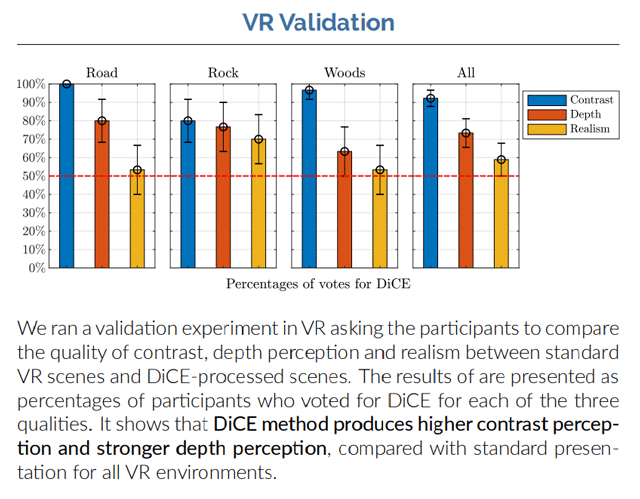
A team of researchers from Cambridge, Berkeley, mit and others have developed a new method to enhance the perceived contrast in VR headsets. This method uses a stereovision by a deliberate mismatch of the elements of the view seen by each eye; the researchers argue that the brain resolves the conflict in such a way that enhances the perceived contrast.
Lately most of the major manufacturers virtual headsets switched from OLED displays to LCD displays. The latter offers a higher pixel density, reduced effect door screen and probably lower cost, with the largest trade — off contrast. While OLED displays offer a wide range of contrast and especially deep blacks, the LCD displays in modern headsets look more blurry, especially in dark scenes.
Researchers from Cambridge, Durham, INRIA, University of the côte d’azur, Berkeley, Rennes and mit have developed a new technique which can help boost the perceived contrast in virtual reality headsets. The system is called DiCE, which means “strengthening diopticerne contrast”. In an article published earlier this year in the journal ACM Transactions on Graphics , researchers claim that the method is “negligible computational cost and can be directly used for visualization of virtual reality in real time.”
The researchers say that, although the methods of tone display can increase the perceived contrast on the images, they are too slow and computationally expensive for practical use when rendering a virtual reality. Instead, they propose a system that uses the natural behavior of the human stereo vision system, to make it perceive more contrast.
In General, the purpose of VR headsets is always to reproduce the stereo image accurate; if the image to be displayed to each eye, has unexpected differences, it creates “binocular rivalry” (stereo AKA conflict), which can be visually uncomfortable, because it creates a discrepancy that the brain is difficult to correctly merge into a coherent image. Method DiCE is directed to the use of divergent stereo image to enhance contrast while controlling binocular rivalry.
A key component of the method is figuring out how to visualize the image to enhance contrast without a significant binocular rivalry. The researchers say they conducted an experiment to determine the factors that lead to binocular rivalry, and then developed contrast enhancement based on the stereo to avoid these factors.
The main problem of our approach is to achieve the right balance between contrast enhancement and visual discomfort caused by binocular rivalry. To solve this problem, we conducted a psychophysical experiment to test how the content, parameters and observer parameters tone curve can affect binocular rivalry arising from diopticerne view. We found that the ratio of the slopes of the curve tones can predict binocular rivalry, allowing us to easily control the shape of the curves diopticerne tones.
Finding an approach that minimizes binocular rivalry, researchers checked their results, stating that “our results clearly show that our solution is more effective for increasing the contrast and at the same time much more efficiently [than previous methods]. We also assessed the installation of VR where users indicate that our approach clearly improves contrast and depth compared to the baseline level”.

Researchers believe that this work is well suited for rendering of virtual reality, noting that “since the tone mapping is usually part of the rendering pipeline, our technique can be easily combined with an existing rendering, VR / AR with virtually no cost [of computing]”. The team even came down to the fact that you have published a Unity Asset package to other researchers.
The research group included Panchen Jung, George Alex Mulieris, George Drettakis, Martin S. banks, Mathieu Shamba, Fredo Durand and Rafal K. Mantiuk.
Source








